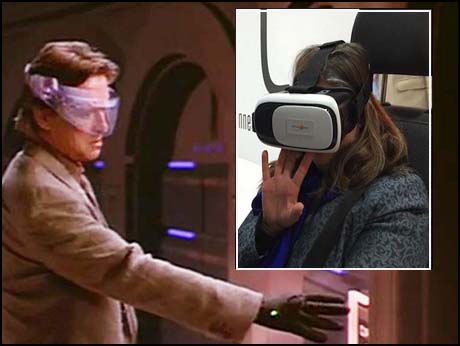
Virtual Reality has moved beyond buzzword to offer the rest of us, an addictive, immersive new environment for work and play. Welcome to Maya Bazaar!
INDIATECHONLINE Special Focus
Bangalore, April 24 2016
There was a time when people didn't mind the stares of passers by , as they stuck huge brick-sized contraptions -- early mobile phones-- to their faces and shouted into them. A decade later they didn't mind to be taken for loonies, as they spoke in public, seemingly to themselves, using earpieces with their handsets. This year, get set for another bunch of goofies who will soon appear in public, their heads encased in all-encompassing goggles. Spare your scorn: they're busy in a virtual duniya of their own , touching the future -- virtually.
Virtual Reality (VR) headsets are now widely available -- and while the big global offerings this year, may come with an asking price of Rs 50,000 to Rs 1 lakh, jugaad is at work here too -- and Indian innovators have already launched VR gear that costs than Rs 2000, or is even given away free with some smart phone brands. What's more, young Indian developers have created an ecosystem of 3-D VR content, without which, the most fancy headsets are so much headache rather than a heady experience.
Yet VR as we know it today is in fact the Second Coming of the technology and like so many of today's personal technologies like smart watches and gesture controls, drew inspiration from science fiction. The termVR first popped up in 'The Judas Mandala', a 1982 novel by Australian Damien Broderick. Ten years later immersive and computer simulated 3-D environments were created at enormous expense, using special studios, head-mounted LCD displays, special haptic ( that is, touchy-feely) gloves fed by powerful desktop computers.
Remember Michael Douglas as the embattled techie in the film version of Michael Crichton's thriller "Disclosure" entering the VR system of his company to access the records spiked by his vengeful female boss ( Demi Moore)? That was 1994, and one of the first visualizations of VR that the lay public got to see
That same year, the late Dr N. Seshagiri, then Director -General, National Informatics Centre, had set up one of the world's first VR Labs in Delhi -- VELNIC or the Virtual Environment Lab of NIC. He made a dramatic entrance in Hyderabad, a few weeks later, at the Indian Computer Congress, wearing a VR head set as he delivered his keynote address, illustrating how all government records could be virtualized and stored for posterity the VR way. Fiction had morphed into fact.
The 1990s brand of VR was too elitist and too costly ( the Indian VELNIC system, one of the cheapest in the world, cost the equivalent of $ 80,000), to make much of an impact except as a tool for the military to mimic war games. It shrivelled and died --- only to see nirvana two decades later, around 2014.
Meanwhile the geeks had learnt their lesson: technology had to touch people if it was to be meaningful or commercially viable. VR Mark II is doing just that.
In March 2014, Facebook spent $ 2 billion to acquire a US company, Oculus VR, that was making the modern virtual reality headset. Their product, Oculus Rift was finally launched in a few select markets earlier this year, but its India availability has not been announced. The Rift is a $ 599 (Rs 40,000) headset which was widely praised as the most immersive product in this niche -- till a few weeks ago, the Taiwan-based HTC upstaged it with its own offering , Vive, at $ 799 (Rs 56000). While Rift -- thanks to its Microsoft connection --uses the XBox game pad as its controller, Vive comes with dedicated motion controllers and a set of base stations. (Read our preview of HTC Vive here)
_____________________________________________
For Indian innovation in VR, see our special feature
_____________________________________________
Both these contenders at the pricey end of VR need a dedicated, graphics-enabled PC to work. Add that cost and they are well above Rs 1 lakh. Sony has announced its own VR headset which will work with the PlayStation 4 console but the product is not expected till October.
The need to tether the VR system to a computer may yet become a roadblock for such systems -- unless they can come up with an experience that is literally out of this world. Meanwhile, a disruptor has appeared on the scene -- VR headsets that are stripped down in their abilities and harness the computing power of a smart phone rather than a PC. Samsung's Gear VR is a leader in this new, emerging segment but its use is limited to a small range of Samsung phones. ( read our review here )
With neither Oculus Rift nor HTC hive available here, the phone-based VR segment is exploiting its window of opportunity. Last year, Google launched a very basic do-it-yourself headset called Cardboard -- which was just that, a brown box with a couple of lenses stuck in and with rubber bands to hold the phone. You can buy a kit online for about Rs 500. Companies like OnePlus and last week Tata Motors, have given away such kits for free, in millions to promote their products with a compatible 3-D VR app.